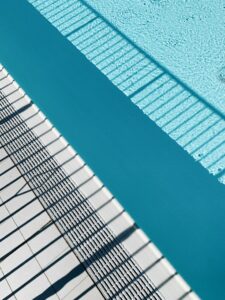WHAT IS SOLAR POOL HEATING?
Heating a swimming pool for the season can cost a significant amount. One way to reduce swimming pool heating costs is to install a solar pool heater. They’re commanded competitive with gas and heat pump pool heaters and have meager annual operating expenses.

The payback period
The Payback period is the time it takes for your fuel savings to equal the cost of your solar heating system. Sometimes, it can be as short as two to three swimming seasons.
After that, your energy savings continue for the life of the system. By replacing or reducing conventional pool heaters, solar heaters help eliminate greenhouse gases, such as carbon dioxide, that impact our climate.
Pool systems usually use simple, low-cost, unglazed plastic collectors that mount on a nearby roof. The pump you already use for filtering pool water will circulate water through the solar collectors to be warmed by the sun.
Want to start small?
Pool owners who want a shorter swimming season or plan to use a backup gas or electric heater will only need a small collector area. Those using a fuel heater will find that a complementary solar heater makes economic sense because of the savings in fuel. Smaller systems can usually be enlarged, if required, in the future.
WHY BUY A SOLAR POOL HEATER?
1. Solar saves on pool heating costs. You could spend five times (or more!) on pool heating with gas than solar heating. Once the system is installed, there are no more heating bills.
2. Solar extends your swimming time.
You can keep your pool open longer with free energy from the sun. Even in the coldest areas of New York, a solar heater used in conjunction with a solar pool cover can add six weeks to the season.
3. Solar equipment lasts a long time.
With proper maintenance, you can expect the equipment installed by our company to last ten to twenty years or more.
4. Solar equipment requires less maintenance. Fewer parts to break down means less cost to maintain. Simple! A solar heating system doesn’t need as much care as a gas or electric heater, which translates into less cost for you, the pool owner.
In contrast, most gas heaters come with a two-year warranty.
5. Solar energy is good for the environment.
HOW DOES A SOLAR POOL HEATER WORK?
Unlike solar domestic water heating systems, which raise a small amount of water to a high temperature of about 140°F, pool heaters raise the temperature of several thousand gallons to about 80°F by circulating the water at a relatively fast rate through the collectors.
This allows most solar energy falling on the collectors to transfer to the pool water. Pool water is pumped through a filter and then through the solar collector(s), where it is heated before it is returned to the pool.
Most solar pool heating systems include the following:
• A solar collector — the device through which pool water is circulated to be heated by the sun. When suitable roof space is unavailable, collectors can be ground-mounted on a rack.
• A filter — removes debris before water is pumped through the collector
• A pump — circulates water through the filter and collector and back to the pool. The existing pool pump circulates water from the reservoir through the solar collectors and back to the collection.
• A flow control valve — an automatic or manual device that diverts pool water through the solar collector.
SOLAR POOL HEATING SYSTEM INSTALLATION AND MAINTENANCE

The proper installation of a solar pool heating system depends on many factors. These factors include solar resources, climate, local building code requirements, and safety issues. Therefore, it’s best to have a qualified solar thermal systems contractor, like our company, install your system.
After installation, properly maintaining your system will keep it running smoothly for 10–20 years. Your collector should require little maintenance if the pool’s chemical balance and filtering system are checked regularly.
Call today to learn how simple and cost-effective a Solar Pool Heating system can be!